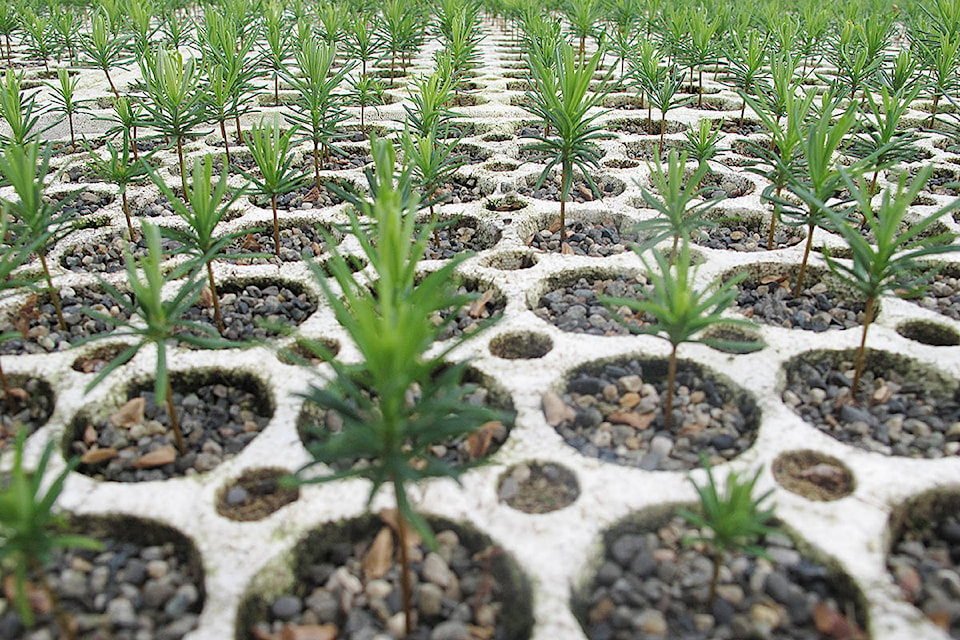Next in a series of article provided by the Campbell River Forestry Task Force
Two local tree nurseries producing millions of seedlings each year are securing future forests and future jobs in the forest industry.
Private and public forest companies are required by legislation to reforest harvested or fire loss areas in British Columbia. Pacific Reforestation Technologies (PRT) and Sylvan Vale help supply seedlings for the estimated 17 million seedlings planted every year on B.C.’s coast.
In Black Creek, three generations of the same family have been growing trees at the Sylvan Vale nursery since 1980. The parents of the current managers – twin sisters Iola Elder and Siriol Paquet – established the nursery in a converted garage and sheep barn. Thirty-eight years later, the nursery has expanded to 18.5 hectares of growing space with 46 greenhouses. Sylvan Vale now grows more than seven million seedlings per year, in addition to ornamentals, grasses, berry and restoration plants.
PRT operates 15 nurseries in Canada and the United States. PRT Campbell River has the capacity to grow 15 million seedlings in 40 greenhouses on 100 hectares. They produce 14 commercial tree species.
Forest companies initiate the growing process with seedling orders stipulating species and seedling size. Depending on the planting season, orders are placed 12 to 18 months in advance. Both nurseries grow spring and fall planting crops simultaneously under different ordering and growing timelines.
With so many trees and different growing regimes, PRT nursery manager James Farrer finds the biggest challenge to be, “keeping on top of all the decisions that need to be made on a daily and weekly basis. Plants don’t wait for us. We have to work their schedule.”
Once growing space is reserved, the next priority is seed, which can be purchase seed from private or government seed orchards. Both produce high quality, genetically improved seed, which can lead to increased forest productivity or pest resistance.
“I rely on logging plans and ecology data to predict seedling needs,” says Taisa Brown, a registered professional forester with Western Forest Products. “We choose genetically suitable seed for the climate and ecological conditions of the planting area,” Brown adds.
The nursery prepares the seed for germination by mimicking natural conditions and breaking seed dormancy. Seeds are sown into cells of Styrofoam trays with a peat moss growing medium. The whole process is mechanized, and it’s possible to sow more than 4,500 trays per day. Trays are moved into greenhouses, polyethylene film covered structures with heat and ventilation, where computer sensors control light, moisture, and temperatures to optimize crop performance.
“The system saves time, provides better monitoring, and controls the environment,” says Farrer. This is important because the watering and fertilization regime “can make or break the crop. Too much or too little of either can seriously set you back and also open your crops up to injury or disease.”
Along with limiting the nursery’s ability to fulfill a contract, unidentified disease in the nursery can lead to poor performance and significant mortality in the field.
Once contract size requirements are met, the seedlings are lifted for immediate fall planting or winter storage. The seedlings are removed from the trays, graded for quality, bundled, wrapped, and boxed during a relatively short window.
The nurseries run two shifts, one during the day and one at night, to lift all the trees on time. Between PRT and Sylvan Vale, more than 100 additional employees are hired for this peak season.
Meeting the legal requirements to reforest cutblocks with the 17 million seedlings planted every year on B.C.’s coast would not be feasible without PRT and Sylvan Vale.
“The local nurseries are doing more than just growing seedlings and ensuring sustainable forest practices,” Brown says. “They also grow Campbell River’s economy and provide employment opportunities.”
For more information on the nurseries or employment opportunities, visit prt.com, svnltd.com, or niefs.net.
